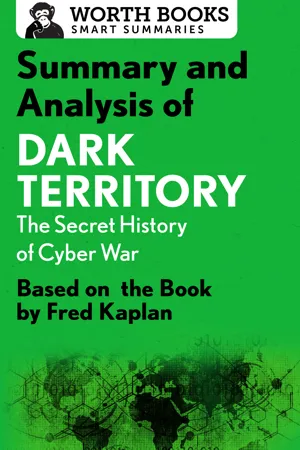Summary
Chapter 1: “Could Something Like This Really Happen?”
In June of 1983, President Reagan first saw the Hollywood blockbuster WarGames. Watching a tech-whiz kid who inadvertently hacks into NORAD (North American Aerospace Defense Command) and nearly starts World War III made Reagan wonder—just how vulnerable was the United States to such an attack? The answer surprised him. A similar attack was possible. Immediately, he charged the NSA with securing all computer networks and servers in the country.
However, the order was short lived, as many viewed it as overreach. The issue largely disappeared until the Clinton administration, when the country was hit by several cyber attacks. Yet it wasn’t until Barack Obama’s presidency that the United States created its first Cyber Command, and, in a time of shrinking military budgets, funded it massively.
The precursor to the NSA was created during World War I. Early cyber warfare techniques focused on gathering SIGINT (signals intelligence) by listening to communications. Over the years, it developed electronic spying techniques, such as tapping into microwave broadcasts to determine what the Soviets and other potential adversaries were up to. The United States stuffed the tenth floor of its Moscow embassy with monitoring equipment. But the Russians, too, could play this game, and began employing similar tactics against the United States.
In the 1960s the Defense Department created ARPANET, a program under the Advanced Research Project Agency, which was tasked with researching “futuristic” military weapons. An inadvertent forerunner to the Internet, it had been established to help scientists and the military share research. This created security concerns regarding classified information. These worries were waved off with the assertion that it would take decades for America’s adversaries to be able to hack into the system. While this assumption was true, it fostered the creation of an unsecured network.
However, once technology made it possible to disable or destroy targets through a cyber attack, it dramatically escalated the risk and reward of cyber warfare.
Need to Know: A program created to help scientists share research invented what we know today as the Internet—also opening the door to cyber warfare and cyber attacks.
Chapter 2: “It’s All About the Information.”
When Iraqi leader Saddam Hussein invaded Kuwait in 1990, President George H. W. Bush retaliated with Operation Desert Storm, quickly defeating the Iraqi army. The NSA facilitated this achievement, monitoring and disabling Iraq’s communications so that the United States could avoid traps and emerge with minimal casualties. However, the military was reluctant to wage cyber warfare itself: Commanding general Norman Schwarzkopf refused to disable infrastructure electronically rather than blow it up, and Secretary of Defense Dick Cheney also preferred bombing to hacking. Because of their refusal, Iraqi civilians on the ground lost their lives.
Mike McConnell, head of the NSA in the early 1990s, knew about the power of hacking. But he was concerned about the possibility of voice encryption, and how it could render their existing phone surveillance methods impossible. To combat that threat, he wanted to install something called a Clipper Chip inside every phone. The complicated chip, which would have increased the cost of the phone to $1,000, was doomed from the start, especially since many doubted it was truly secure.
Need to Know: During Operation Desert Storm, the NSA and others wanted to use cyber attacks to disrupt critical infrastructure, but were overruled. Cyber attacks were still in their infancy.
Chapter 3: A Cyber Pearl Harbor
The April 19, 1995, Oklahoma City bombing was the impetus for the creation of the Critical Infrastructure Working Group. The administration of President Bill Clinton had been floored by how easily lone terrorist Timothy McVeigh, with only a truck bomb, had killed 168 people and caused $600 million in damages.
Rich Wilhelm, NSA director of information warfare, was an important member. He helped the group realize that computer hacking and other online activity could cause as much damage as a terrorist attack—if not more. Meanwhile, attacks were already happening: a Russian crime group had hacked into Citibank computers and taken $10 million, while another hacker posted sensitive information about terrorism on the Internet. When one estimate—almost certainly hugely exaggerated—put the number of yearly attacks on the Defense Department at 250,000, it was enough to spur the creation of a presidential commission.
Getting the commission off the ground was a slow affair, as there were minor battles over both members and leadership. The administration settled on Robert T. Marsh, a retired Air Force general. The Marsh Commission produced a report that sent shockwaves through the government, and Clinton began to speak publicly about cyber attacks.
Need to Know: While inform...
